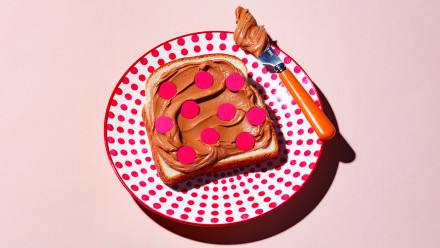Photo: iStockphoto
Milk is a mainstay in many children’s diets, found in everything from infant formulas to birthday cakes. But if your child is allergic, it can be tough to avoid. If milk is off the menu, it’s important to replace it with alternative sources of calcium and vitamin D. Here’s what you need to know to keep your kid safe and healthy if they have a milk allergy.
What is a milk allergy?
A milk allergy occurs when the immune system mistakenly identifies one or more of the proteins in milk as dangerous and mounts an attack, releasing chemicals that cause an allergic reaction. A reaction to milk is usually mild to moderate, but anaphylaxis can occur in one to two percent of cases. This makes it one of the most common foods to cause a life-threatening reaction, along with peanuts and tree nuts.
What’s the difference between a milk allergy and lactose intolerance?
While “allergy” and “intolerance” are often used interchangeably, they have completely different meanings. Lactose intolerance occurs when you have low levels of the enzyme lactase in your gut to help you break down the carbohydrate lactose in milk. This can cause gastrointestinal symptoms such as bloating, gas and diarrhea.
“Milk allergies are very different from lactose intolerance,” says Maria Triassi Asper, an allergist at The Hospital for Sick Children in Toronto. “Although it can cause pain and discomfort, lactose intolerance is not a life-threatening condition, whereas a milk allergy is an allergy to the protein in milk and can cause anaphylaxis, a life-threatening reaction.”
How common is a milk allergy?

Your guide to life after a food allergy diagnosisA cow’s milk allergy is the most common food allergy among children, affecting two to three percent of kids. Children can typically develop a milk allergy in the first six months of life and very rarely after their first birthday. One study found that most infants develop symptoms before one month of age, often within one week of being introduced to formula with cow’s milk protein. It’s rare, but breastfed babies can have a reaction to dairy consumed by their mothers that passes into breastmilk. However, most infants who have a reaction have directly consumed cow’s milk.
What are the symptoms of a milk allergy?
Symptoms of a milk allergy usually show up within minutes of consumption and range in severity. The most common symptoms—affecting 50 to 60 percent of kids with allergies—involve the skin and gastrointestinal system. Skin symptoms may include hives, rash, itchiness and swelling, and gastrointestinal symptoms may include nausea, tummy aches, vomiting and diarrhea. In about 20 to 30 percent of cases, the respiratory system is involved, leading to symptoms like shortness of breath, chest and throat tightness, coughing and wheezing.
Anaphylaxis is a severe allergic reaction that typically comes on quickly and involves two or more body systems, such as the skin and the cardiovascular system. The most serious symptoms of anaphylaxis are difficulty breathing and a drop in blood pressure, which may cause a child to lose colour, become dizzy and even pass out. If your child is having a severe reaction, you should call 911 immediately.
How do you treat a milk allergy?
If your child is having a mild reaction to milk for the first time, such as hives, you should monitor them closely and see your doctor as soon as possible. If the reaction progresses or involves more than one symptom, you should call 911.
At the hospital, your child may be treated with epinephrine, a life-saving drug that stops the reaction. They may also be given secondary medications, such as steroids and antihistamines, to treat residual symptoms like hives and wheezing.
Epinephrine is available for home use in an auto-injector (called by the brand name EpiPen in Canada). Once your child is diagnosed with a milk allergy, you should always have an EpiPen on hand and make sure that everyone who takes care of your child knows how to use it. At the first sign of a serious reaction, you should give the child an EpiPen and call 911.
“If there’s any doubt in your mind about what you should do, administer the EpiPen,” says Triassi Asper. “We know that delaying treatment with epinephrine can lead to a higher incidence of death and poor outcomes.”
If you’re certain that your child is not experiencing anaphylaxis and their symptoms are bothering them, you can give them an antihistamine.
Is there a cure for a milk allergy?
While there is no cure for a milk allergy, research shows that oral immunotherapy for milk improves the chances of achieving tolerance. However, it’s not standard treatment—and is unlikely to be covered by provincial health insurance plans. Oral immunotherapy involves increasing doses of an allergen to build up tolerance. This means that the child can consume some milk without having a reaction, but this runs the risk of causing severe reactions and is not yet recommended for routine clinical practice. Oral immunotherapy should always be done under the supervision of an allergist.
How do you diagnose a milk allergy?
If you think your child may be allergic to milk, you should see your doctor and get a referral to an allergist. To make a diagnosis, the allergist will ask about your child’s reaction to milk and do a skin prick test, a blood test or both.
Allergists typically start with the skin prick test, which involves exposing a small area of the skin to the allergen and seeing how big of a weal (an area of irritated skin) develops. The larger the area of irritated skin, the more likely your child is allergic. If the skin prick test is not conclusive, a blood test may be ordered.
At follow-up appointments, usually every six months to a year, your allergist will likely do the skin prick test again to see if the weal has reduced in size, which may suggest that your child is outgrowing the allergy. If your allergist determines that it’s safe, your child will be offered an oral food challenge, which involves consuming a small amount of milk under the supervision of the allergist to see if they have a reaction.
Tolerating baked milk
Up to 80 percent of children who are allergic to milk can tolerate it in baked goods because the heating process changes the protein for which they have a sensitivity. A protein may also become less allergenic when it interacts with other foods, such as wheat in a muffin.
If a child has reacted to milk on its own but not in baked goods, Triassi Asper encourages them to continue eating baked products. If they haven’t tried baked goods, she will do additional testing to see if they can tolerate the protein that doesn’t get broken down in the baking process. (The testing assesses the level of the specific immunoglobulin E antibodies that react to the casein protein in the blood.) If the antibody levels are low, she will do an oral food challenge, which involves baking a muffin using a standard recipe and then bringing it to the doctor’s office for the child to eat under supervision. Skin testing to the baked muffin that contains milk can also suggest whether it is safe to consider an oral challenge. Ultimately, a full serving of milk needs to be consumed in order to declare that someone has outgrown the allergy.
“If they can tolerate milk in baked form, I encourage them to consume it that way as often as possible—ideally, two or three times a week—to see if they can grow out of the allergy,” says Triassi Asper. She adds that tolerance of baked milk is a good way to predict who is more likely to outgrow the allergy altogether. “There can be certain degrees of tolerance for other products, such as cheese on pizza, but right off the bat, the distinction we make is if someone can tolerate baked cow’s milk or not,” she says.
What foods should your child avoid if they have a milk allergy?
If a child is allergic to milk, they should avoid all dairy products. If a breastfeeding baby reacts, the mother should eliminate dairy from her diet, including yogurt, cheese and ice cream.
If your formula-fed baby is allergic, you will have to avoid milk-based products. Fortunately, there are other options, including extensively hydrolyzed formula (in which the protein has been completely broken down) and soy-based formula. These milk alternatives are fortified with calcium and vitamin D, so you don’t have to worry about your baby’s nutrition.
What about milk alternatives, such as soy milk, goat milk and sheep milk?
While there are many dairy alternatives, milk protein can also show up in products like soy cheese, so it’s important to always read the labels on products. Milk is considered a priority allergen by Health Canada and must be clearly labelled if it’s in a product.
About 85 to 90 percent of kids who are allergic to milk are also allergic to other animal milks, such as goat milk and sheep milk. “If someone is allergic to cow’s milk, I recommend avoiding all milks because they’re very likely to react,” says Triassi Asper, who adds that some children are also allergic to soy milk. “They should go with a completely different milk product to get their calcium.”
A plethora of products in the grocery store contain cow’s milk, including cereals, crackers, baked goods, sauces and frozen meals. There are also lots of unexpected sources of milk protein, such as brown sugar, hot dogs and the wax on fruit. It can even show up in non-food products, such as medication and personal care products. “I always advise parents to read the label on anything they give their child,” says Triassi Asper. “It’s just a good habit to adopt.”
If your child can’t consume dairy, it’s important to ensure that they get enough calcium and vitamin D through other foods, such as beans, lentils, fish and fortified foods, to avoid nutritional deficiencies that may affect their growth and development.
Can a milk allergy be outgrown?
The good news is that children with milk allergies are very likely to outgrow them, and those who can tolerate baked milk may outgrow them faster. One study found that 45 to 50 percent of kids outgrow them by age one, 60 to 75 percent by age two and 85 to 90 percent by age three.
Read more:
When your child’s food allergy leads to anxiety
Does milk really do your kid’s body good?


